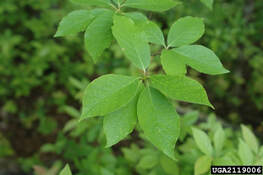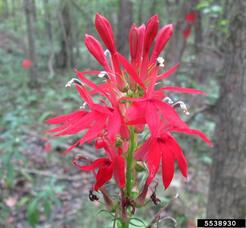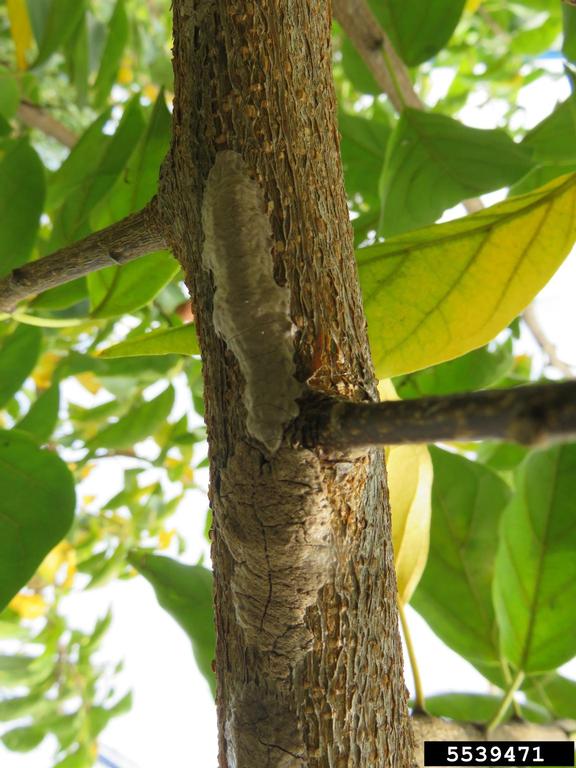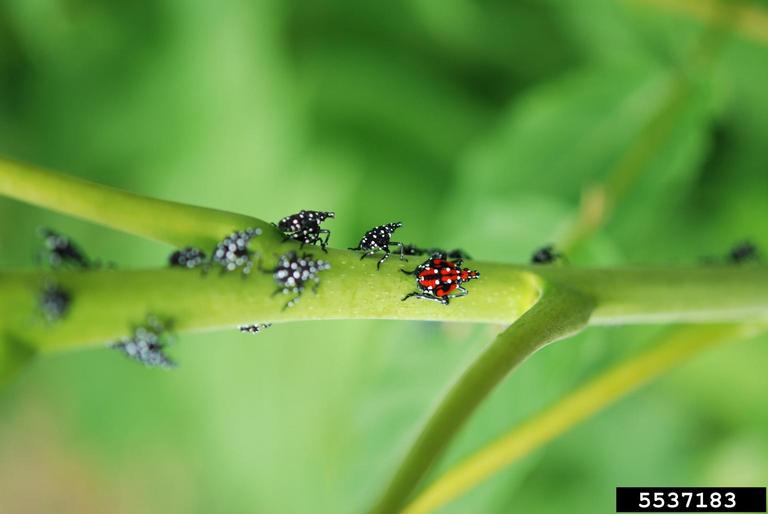|
Adult SLF- Photo credit: Lawrence Barringer, Pennsylvania Sept. of Agriculture Citizens are urged to be careful not to bring the Spotted Lantern Fly (SLF) home with them as a hitchhiker. People driving out of state or to parts of Ohio with known infestations should inspect and/or wash their vehicles upon return to ensure these insects have not accidentally traveled back with them. Spotted Lantern Fly (SLF) which is an invasive plant hopper that is native to China was found in Pennsylvania in 2014. In late 2020, SLF was found in southern Ohio in Mingo Junction and in northern Ohio, Cuyahoga County in 2021. It is a major pest of crops including grapes, apples, hops, walnuts and hardwood trees. Nymphs and adults prefer to feed on the invasive tree of heaven (Ailanthus altissima) but can feed on more than 70 plant species, and has the potential to greatly impact the viticulture, tree fruit, nursery, and timber industries. The insects suck sap from stems and branches which can weaken and damage the plant. The feeding can result in oozing sap, wilting, leaf curling, and dieback. In addition, during feeding the SLF secretes honeydew which can buildup on and underneath the plant, which in turn promotes the growth of black sooty mold. Black sooty mold around the base of plants or oozing sap may indicate the presence of the spotted lanternfly, however other pests can cause these symptoms as well. Black sooty mold is harmless to people however it causes damage to plants. In counties infested and quarantined for spotted lanternfly, residents report hundreds of these insects that affect their quality of life and ability to enjoy the outdoors during the spring and summer months. Spotted lanternflies will cover trees, swarm in the air, and their honeydew can coat decks and play equipment. Egg mass- Photo credit: Kenneth R. Law, USDA APHIS PPQ Immature SLF- Photo credit: Lawrence Barringer, Pennsylvania Sept. of Agriculture SLF will lay eggs beginning in October through the beginning of winter. The egg masses of the SLF are small, grey masses protected by a waxy covering. After hatching in late spring, the SLF goes through four nymph stages. During the first three they appear black with white spots, and in the last stage, which typically occurs during mid-summer, they are red with white dots and black stripes. During the late summer and autumn, the SLF is in the adult moth stage. These adults are larger (approximately 1 inch), with black bodies and brightly colored wings.
Spotted lanternfly, which likely arrived on imported goods from Asia, is a plant hopper and not a strong flier. It is moved greater distances by people moving infested materials. It lays eggs on almost any surface, including vehicles, trailers, outdoor equipment, patio furniture, etc. Egg masses can be removed by scrapping with a hard or rigid tool and disposed of into a container of rubbing alcohol. Early detection is critical to prevent economic and ecological losses. The public has played a key role in detecting spotted lanternfly and the success of stopping its spread depends on help from the public to look for and report signs of the pest. If you suspect a spotted lanternfly infestation, at any life stage, please report the finding to the Ohio Department of Agriculture Plant Pest Control (614-728-6400, [email protected]), your local OSU Extension specialist (https://extension.osu.edu) or by using the Great Lakes Early Detection mobile reporting app (https://apps.bugwood.org/apps/gledn/). For more questions regarding Warren County Soil and Water Conservation District programs and/or technical assistance on water or soil questions, visit http://warrenswcd.com or call, 513-695-1337.
1 Comment
Ohio’s native plants provide many wonderful benefits to pollinators, Ohio’s economy, and the health of Ohio’s ecosystems. We can see many of these common natives right here in Warren County!  Black Gum Tree Black Gum Tree (Nyssa sylvatica), otherwise known as black gum, black tupelo or sour gum, is a native for most parts of Ohio. This tree has a wonderful glossy dark green foliage in the summer and turns to a bright orange-red in the autumn. At maturity, this tree has a oval shape and can reach heights of 60’ with a width of 25’. The black tupelo strongly prefers moist, well-drained, acidic soils but adapts to average, alkaline soils. This tree need full sun to partial sun to grow well. Reference: http://forestry.ohiodnr.gov/tupelo Photo credit: Chris Evans, University of Illinois, Bugwood.org  Sassafras Sassafras (Sassafras albidum) is an aromatic, native tree found in wooded areas of Ohio. It is part of the Lauraceae family that includes such genera as spicebush (another great native) and avocado. This tree prefers moist, well-drained, soils and can reach a size of 30-50' in height and 25-40' in width. The leaves are uniquely shaped and can range from three lobed, mitten shaped to unlobed. Reference: https://bygl.osu.edu/node/739 Photo credit: Ansel Oommen, Bugwood.org  White Snakeroot White snakeroot (Ageratina altissima) is a herbaceous perennial plant that is often considered a weed because of its toxicity to animals and humans. It is part of the sunflower family and is identified by the white disk flowers that appear in late summer and early fall. It has an interesting history as it was known to cause “milk sickness”. Milk from cows who had ingested this plant would contain high levels of the toxin tremetol. Numerous early settlers, including Abraham Lincoln’s mother, became afflicted and/or died from milk sickness in the Midwest. Reference: https://u.osu.edu/dassler.1/2014/09/14/eupatorium-rugosum/ https://nature.mdc.mo.gov/discover-nature/field-guide/white-snakeroot Photo credit: David Stephens, Bugwood.org  Canadian Wild Ginger Canadian wild ginger (Asarum canadense) is a perennial, low growing plant (4-8" high) that blooms in April, May and June and is typically found in shady areas. This is a colony forming (you will typically find more than one in the same location) plant that produces a pair of large, velvety, heart-shaped leaves. A ginger plant produces one flower at the base of the two leaves which can be dark red-brown to green-brown color. This plant is becoming more popular with gardeners as a low maintenance groundcover for shade areas. This plant attracts butterflies and is a larval host to the pipeline swallowtail butterfly. Reference: https://www.wildflower.org/plants/result.php?id_plant=asca https://hgic.clemson.edu/factsheet/wild-ginger/ Photo credit: Karan A. Rawlins, University of Georgia, Bugwood.org  Cardinal Flower Lobelia cardinalis or cardinal flower is a native wildflower that grows in marshes, streambanks and low wooded areas. Cardinal flower has extremely showy red blossoms that grow on a spike. This plant is a must if you want to attract butterflies and hummingbirds as the color is irresistible to these creatures! Cardinal flowers can be grown in full sun or very light shade. The plants require moisture for good growth and they can be planted on the edge of a pond or marsh area. Reference: https://www.fs.fed.us/wildflowers/plant-of-the-week/lobelia_cardinalis.shtml Photo credit: David Stephens, Bugwood.org |
Details
Warren County SWCD Staff BlogA blog to keep you informed on all the latest news at Warren County SWCD and in the conservation world. Archives
May 2024
Categories
All
|
|
|
Contact:PHONE: (513) 695 - 1337
EMAIL: [email protected] HOURS: Monday - Friday 7:30am - 4:00pm (except holidays) Connect:Warren County Soil & Water Conservation District Copyright © 2016
Warren SWCD Privacy Notice. Emails are serviced by Constant Contact. Constant Contact's Privacy Notice. |





